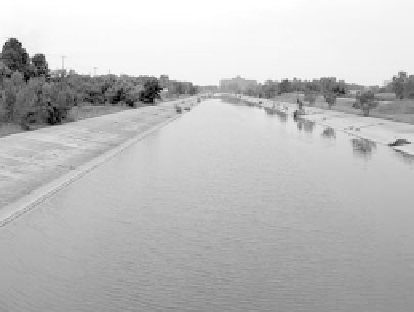Environmental Engineering Reference
In-Depth Information
•
Environmental impacts
. As a function of their larger extent, watersheds exhibit a
wider variety of impacts than parcels.
•
Land tenure and institutional controls
. Most individual parcels are privately owned,
but a mixture of public and private ownership exists across watersheds. The exis-
tence of hundreds, possibly thousands, of private owners having different out-
looks, and with access to streams and lakes, complicates the development of a
consistent management plan for water resources.
•
Levels of awareness and education
. Differences in awareness and education result
largely from the scale differences. It is simply much easier to know the character-
istics of an individual parcel than an entire watershed.
Despite these differences, the general processes of landscape formation, spatial structure
and dynamics, stability, and human impacts also operate at the watershed scale and can
be addressed by a scientific-based planning approach. A history of growth, pollution,
and attempts to control water flow has created an array of environmental impacts within
urbanized watersheds: buried tributaries, streambanks lined with concrete, combined
sewer overflows (CSOs), degraded aquatic habitats, and soil and groundwater contamina-
tion (Figure 15.4). It will require a comprehensive approach and mammoth effort to rectify
these problems. Specifying the details of this process is beyond the scope of this topic.
What can be accomplished here is to introduce a definition of the process of watershed
management, outline its primary stages and components, and specify how the science in
this topic can be applied within this framework.
Watershed management
is the minimization of the human impacts within and between
different land use systems, with the objective of achieving a sustainable landscape. As
bounded landscapes, watersheds are three-dimensional and receive inputs from outside
their boundaries. They have formative processes, undergo constant change, and within
urbanized watersheds, the cultural landscape often displays the outcomes of environmen-
tal impacts initiated and sustained by anthropogenic activities.
One apparent paradox of watershed management is the focus on land. To achieve a sus-
tainable watershed, the land has to be properly managed, and since most watershed sur-
face areas are 90%-95% land, this imperative is justified. The practical question is: How can
science-based planning begin to put urbanized watersheds on the path to sustainability?
The final chapter will answer this question.
FIGURE 15.4
Channelized portion of an urban river.
(Photo by Kent S. Murray.)

Search WWH ::

Custom Search